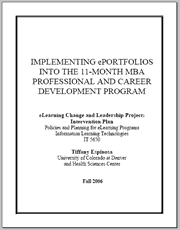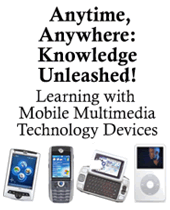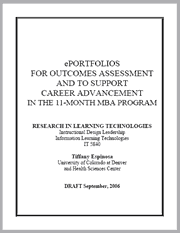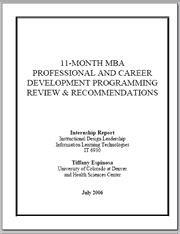
Browse Projects:
Project Competency Matrix |
This project, focusing on Mobile Multimedia Technology Devices, was completed for IT 6740: Learning Processes Applied to Instructional Technologies. The goals for the project were to examine the different ways these devices help us in formal educational settings (like classrooms, distance education, and in studying) and in our lifelong learning by allowing us to learn anything, anywhere and by putting rich learning objects and interactivity it in the palms of our hands.
For this project I created my first video podcast, which represented both being an active and lifelong learner and integrating new tools and technologies into my professional practice (competency 4).
It involved a significant amount of planning and analysis to address not only learner needs, but also to ensure the content and technologies used were relevant and enriching (competencies 5 and 6). I applied the theories and practices we studied in the class, including: message design, information processing, motivation, designing learning objects to appeal to different learning styles and needs, constructivist and situated learning theories (competencies 8, 9, 10).
Writing a Professional Resume
 |
This project, focusing on career development for students, was completed for IT 5660: Developing Educational Websites. The goals for the project were to create an interactive, situated learning experience in order to help job seekers understand how to write effective resumes by seeing it from a recruiter’s point of view.
For this project I created my first website, which represented both being an active and lifelong learner and integrating new tools and technologies into myprofessional practice (competency 4). It was the first foray I had in preparing a technology plan for my organization and represents a successful implementation of a small-scale plan (competency 7).
It involved a significant amount of planning and analysis to address not only learner needs, but also making sure the content and the technologies used were relevant and enriching (competencies 5 and 6). I applied the theories and practices we studied in the class, including: developing technically appropriate and well-designed websites, creating learning objects to appeal to different learning styles and needs and situated learning theories (competencies 8, 9, 10). Additionally, I embedded components into it to promote the development of a community of practice with collaboration and open learning (competency 3) and it included learner assessments to measure performance in informal but authentic ways (competency 12).
How to Interview Effectively
This project, focusing on career development for students, was completed for IT 5130: Instructional Message Design. The goals for the project were to help students understand how to successfully answer some of the most basic but important questions during a job interview.
For this project I created my first website with embedded audio, which represented both being an active and lifelong learner and integrating new tools and technologies into my professional practice (competency 4).
It involved a significant amount of planning and analysis to address not only learner needs, but also making sure the content and the technologies used were relevant and enriching (competencies 5 and 6). I applied the theories and practices we studied in the class, including: developing well-designed multimedia learning objects using constructivist learning theories (competencies 8, 9, 10). Additionally, it included learner assessments to measure knowledge retention and transfer (competency 12).
Action Research Report
This project, focusing on ePortfolio programs in higher education, was completed for IT 5840: Research in Learning Technologies. The goals for the project were to understand what stakeholders (including faculty, administrators, students and HR representatives hiring gradutes) thought about ePortfolio programs and what factors were important in implementing these projects.
For this project I researched the use of e-portfolios in education for assessment, evaluation, and transitioning from school to work. This represented my efforts both at being an active and lifelong learner and integrating new tools, technologies, and trends into my professional practice (competencies 4 and 13). I looked at how to design e-portfolios to be sensitive to their cultural impact (competency 9). In analyzing this topic, one of the main topics I addressed was how to use e-portfolios to assess learner knowledge retention and transfer (competency 12).
Internship Report
This project, an analysis of the Professional Development Programs I run and, was completed for IT 6930: Internship: Information/Learning Technologies. The goals for the project were to review and apply relevant academic research to develop recommendations for future improvements in the program.
For this project I took a systems view of my Professional Development Program curriculum, analyzing systemic relationships and evaluating the program’s outcomes via student surveys (competency 1 and 2). As a part of this study, I looked at ways to promote collaboration and partnerships to leverage the resources available to me and improve the efficacy of the program (competency 3). This study was undertaken as a part of my ethos of continuous improvement and organizational learning, which represented both being an active and lifelong learner and integrating professional development into my daily practice (competencies 4 and 13).
This study involved intense analysis and planning to address the needs, objectives, and environment in which this program is situated (competencies 5 and 6). In critiquing and creating a revised educational plan, I applied the theories and practices I studied throughout my classes, including: learning and behavioral theories, information-processing theories, best practices on designing learning objects and situated learning activities (competencies 7, 8, 9, 10).
I looked at what cultural impacts my program was making and ways to improve them to accommodate a wider range of learning styles and needs (competency 9). In this formative evaluation of my programs, I addressed ways to assess and improve learner knowledge retention and transfer (competencies 11 and 12).
To conclude my study I developed a change strategy which included a plan for implementation, a schedule, ways to manage the process and stakeholders, and ways to evaluate the success of the project (competencies 14 and 15). Finally I have begun the implementation and management of this plan (competency 16).
Leadership Report
 |
This development project was focused on creating an ePortfolio program for my students. It was completed for IT 5650: Policies & Planning for E-Learning Programs. The goals for the project were to use the knowledge gained through my action research project to take the first steps in creating a new e-portfolio program.
For this project I took a systems view in considering implementing a new e-portfolio plan for my students (competency 1 and 2). As a part of this study, I looked at ways to promote collaboration and partnerships with colleagues outside my program to leverage the resources available to the community of academics practicing the use of e-portfolios (competency 3). This study was undertaken as a part of my ethos of continuous improvement and organizational learning, which represented both being an active and lifelong learner and integrating professional development into my daily practice (competencies 4 and 13).
In developing this new plan, I did a significant amount of analysis and planning to address the needs and environment in which this program will be situated (competencies 5, 6, and 7). In this formative evaluation of a new program, I addressed ways to use e-portfolios to assess and improve learner knowledge retention and transfer (competencies 11 and 12).
This implementation and change plan required me to apply theories of adoption and develop a strategy which included a communication plan, ways to manage resistance, a plan for supporting and guiding practice during the adoption, and the roles and responsibilities for all stakeholders (competencies 14 and 15). Finally I have begun the implementation and management of this plan (competency 16).
Browse By Competency
Reflective Practice
-
Understand the situated nature of your work
-
Understand systemic relationships; barriers to change; leverage or tipping points
-
Be aware of values, ethical, legal, and human issues
Projects that meet this competency: Internship Report, Leadership Report
-
Instructional systems design
-
Program/product evaluation and accountability
-
Action research
-
Change leadership
Projects that meet this competency: Action Research Report, Internship Report, Leadership Report
Projects that meet this competency: Writing Resumes, Action Research Report, Internship Report, Leadership Report
-
Be active in the profession and contribute to the community of practice
-
Have a plan for career development and continued professional learning
-
Be open to new tools, technologies, and theories, and determine their best uses in your practice
Projects that meet this competency: Learning with Mobile Multimedia, Writing Resumes, Interviewing Effectively, Action Research Report, Internship Report, Leadership Report
Planning and Analysis
Projects that meet this competency: Learning with Mobile Multimedia, Writing Resumes, Interviewing Effectively, Internship Report, Leadership Report
-
Learners
-
Content, job, or task
-
Goals and objectives
-
Environment, culture, and history
-
External climate; emerging trends and issues
-
Ethical and legal implications
-
Appropriate media and technologies
Projects that meet this competency: Learning with Mobile Multimedia, Writing Resumes, Interviewing Effectively, Leadership Report
Projects that meet this competency: Writing Resumes, Internship Report, Leadership Report
Design and Development
-
Learning theories
-
Behavioral
-
Information-processing
-
Constructivist, situated-learning, activity theory
-
Instructional-design theories
-
Rule-based content
-
Complex environments and communities
-
Theories of meaning and value
-
Aesthetics to guide form and structure
-
Critical theories of power, value, and inclusion
Projects that meet this competency: Learning with Mobile Multimedia, Writing Resumes, Interviewing Effectively
-
Accommodate different learning styles and needs
-
Be sensitive to cultural impact of materials; accommodate diversity factors (e.g., cultural, special needs, gender) that may influence learning
Projects that meet this competency: Learning with Mobile Multimedia, Writing Resumes, Interviewing Effectively, Action Research Report, Internship Report
-
Choose and use appropriate tools and resources for development and production, e.g., multimedia or Web tools, and print or people resources.
-
Apply message-design principles to development of interface and interaction
-
Visual communication and principles of perception
-
Learning via media
-
Principles of movement and interaction within traditional and virtual environments
-
Principles of motivation and attitude change
Projects that meet this competency: Learning with Mobile Multimedia, Writing Resumes, Interviewing Effectively, Internship Report
Evaluation and Assessment
-
Formative evaluation for improvement
-
Summative evaluation for accountability
Projects that meet this competency: Internship Report, Leadership Report
-
Measures of behavioral, cognitive, attitude, and identity change
-
Day-to-day assessment via informal and authentic performance measures
-
Data-based instructional decision-making
-
Standards benchmarking
-
Use of technology for assessment
Projects that meet this competency: Writing Resumes, Interviewing Effectively, Action Research Report, Internship Report, Leadership Report
-
Demonstrate professional improvement through inquiry, action
-
Demonstrate impact of intervention or improved understanding of a problem
Projects that meet this competency: Action Research Report, Internship Report, Leadership Report
Implementation and Change
-
How the effort will be communicated and to whom
-
What implementation materials and messages will be required and how they will be produced
-
A schedule for the rollout, including milestones, timelines, etc.
-
How the new practices will be acknowledged and rewarded
-
How to manage resistance
-
Who will provide support and guide practice during adoption
-
Roles and responsibilities of management, the target audience, and other vested parties
Projects that meet this competency: Internship Report, Leadership Report
-
Develop tools and supports to help implementation, e.g., train-the-trainer sessions, job aids, FAQs, etc.
-
Gather data on the effectiveness of the innovation to guide future efforts
Projects that meet this competency: Internship Report, Leadership Report
Management
-
Instructional-design project
-
Other development projects (information, Web, etc.)
-
Facilities such as lab, library, or classroom
-
Classroom and students
-
Resources such as software collections, hardware, etc.
-
Personnel
-
Information resources
Projects that meet this competency: Internship Report, Leadership Report





